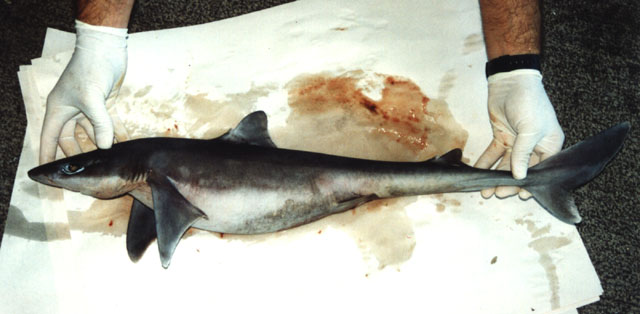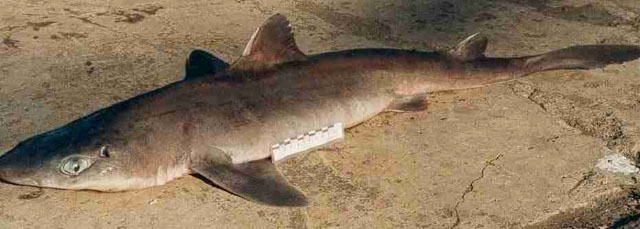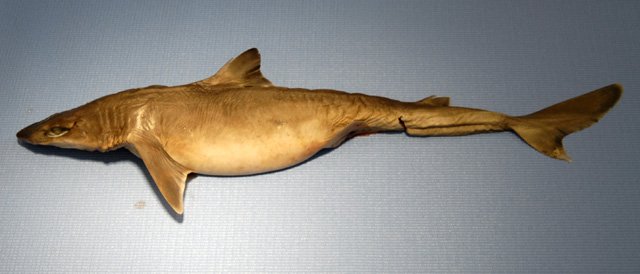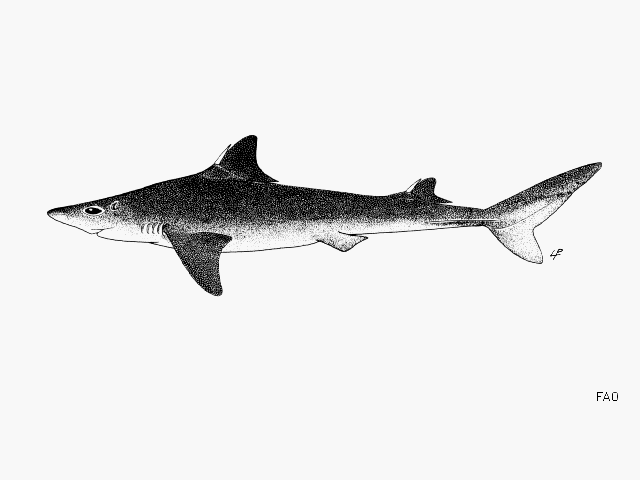Squalus
mitsukurii
Jordan &
Snyder,
1903
Shortspine spurdog
View all media / Upload your photos and videos
Expand all
Classification / Names
Environment / milieu / depth range / climate zone / distribution range
Distribution
Circumglobal in temperate and subtropical waters: Widely distributed in most oceans but possibly consisting of a species complex (Ref. 6871, 31367). Western Indian Ocean: Walters Shoal (MNHN 1991-0406) (Ref. 33390); Eastern Indian Ocean: southern Australia (Ref. 6871); West Pacific: Seamounts in the North Pacific, Japan, Korea, China (and presumably Taiwan and Viet Nam); Southwest Pacific: possibly in New Zealand; Southeast Pacific: Desventuradas Is. and Juan Fernández Is. Southwest Atlantic: Uruguay to Argentina (Ref. 58839). Records of Squalus blainvillei or Squalus fernandinus from the western Indian Ocean, New Caledonia and Chile are based in part on this species. Elsewhere, dogfishes very similar to Squalus mitsukurii are not conspecific with Squalus blainvillei.
Maps

Squalus mitsukurii / Native range
AquaMaps Data sources:
GBIF
OBIS
This map was computer-generated and has not yet been reviewed.

Squalus mitsukurii / Suitable habitat
AquaMaps Data sources:
GBIF
OBIS
This map was computer-generated and has not yet been reviewed.

Squalus mitsukurii / Point map
AquaMaps Data sources:
GBIF
OBIS
This map was computer-generated and has not yet been reviewed.

Squalus mitsukurii / Year 2050
AquaMaps Data sources:
GBIF
OBIS
This map was computer-generated and has not yet been reviewed.
Length at first maturity / Size / Weight / Age
Short description
Dorsal spines (total): 2; Dorsal soft rays (total): 0; Anal spines: 0; Anal soft rays: 0. A large dogfish with a long, angular snout and a small mouth slightly more than half the snout length; body without spots; 1st dorsal fin spine over pectoral fins (Ref. 5578). Pearl-grey above, white below; fins with white edges, sides rarely with white spots (Ref. 5578).
Biology
Found on the continental and insular shelves and upper slopes (Ref. 247, 75154). Perhaps ranging from 4-740 m (Ref. 58302). Feeds on bony fishes including hake, snoek, conger eels and lantern fishes (Ref. 36731), cephalopods, and crustaceans (Ref. 5213). Ovoviviparous (Ref. 205), with about 4 to 9 pups in a litter (Ref. 247).
Life cycle and mating behavior
Ovoviviparous. Probably has 4 to 9 young per litter, most births in autumn, off the east coast of South Africa. There might be a gestation period of up to two years, and sexual segregation of females in the southern part of its range. Size at birth about 22 to 26 cm.
Main reference
Compagno, L.J.V. 1984 FAO Species Catalogue. Vol. 4. Sharks of the world. An annotated and illustrated catalogue of shark species known to date. Part 1 - Hexanchiformes to Lamniformes. FAO Fish. Synop. 125(4/1):1-249. Rome, FAO. (Ref. 247)
IUCN Red List Status (Ref. 125652)
Endangered (EN), A2d; date assessed: November 21 2019
CITES (Ref. 131153)
Not Evaluated
CMS (Ref. 116361)
Not Evaluated
Threat to humans
Harmless
More information
- Countries
- FAO areas
- Ecosystems
- Occurrences
- Introductions
- Stocks
- Ecology
- Diet
- Food items
- Food consumption
- Ration
- Common names
- Synonyms
- Metabolism
- Predators
- Ecotoxicology
- Reproduction
- Maturity
- Spawning
- Spawning aggregation
- Fecundity
- Eggs
- Egg development
- Age/Size
- Growth
- Length-weight
- Length-length
- Length-frequencies
- Morphometrics
- Morphology
- Larvae
- Larval dynamics
- Recruitment
- Abundance
- References
- Aquaculture
- Aquaculture profile
- Strains
- Genetics
- Allele frequencies
- Heritability
- Diseases
- Processing
- Mass conversion
- Vision
- Pictures
- Stamps, Coins Misc.
- Sounds
- Ciguatera
- Speed
- Swim. type
- Gill area
- Otoliths
- Brains
Estimates based on models
Preferred temperature (Ref. 123201): 6.4 - 21.9, mean 14.1 °C (based on 1219 cells).
Phylogenetic diversity index (Ref. 82804): PD50 = 0.5 [Uniqueness, from 0.5 = low to 2.0 = high].
Bayesian length-weight: a=0.00295 (0.00176 - 0.00496), b=3.07 (2.92 - 3.22), in cm total length, based on LWR estimates for this species & Genus-body shape (Ref. 93245).
Trophic level (Ref. 69278): 4.4 ±0.3 se; Based on diet studies.
Resilience (Ref. 120179): Very low, minimum population doubling time more than 14 years (Fec=4).
Fishing vulnerability (Ref. 59153): High vulnerability (58 of 100).
Price category (Ref. 80766): Medium; Questionable: based on ex-vessel price for species in this genus.
Nutrients (Ref. 124155): Calcium = 5.8 [1.1, 29.3] mg/100g; Iron = 0.244 [0.057, 0.768] mg/100g; Protein = 17.2 [15.5, 18.9] %; Omega3 = 0.358 [0.127, 0.938] g/100g; Selenium = 14 [4, 44] μg/100g; VitaminA = 22.6 [5.0, 112.6] μg/100g; Zinc = 0.32 [0.15, 0.64] mg/100g (wet weight);






